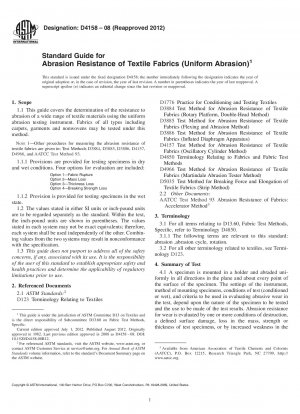ASTM D4158-08(2012)
Standard Guide for Abrasion Resistance of Textile Fabrics (Uniform Abrasion)
- Standard No.
- ASTM D4158-08(2012)
- Release Date
- 2008
- Published By
- American Society for Testing and Materials (ASTM)
- Status
- Replace By
- ASTM D4158-08(2016)
- Latest
- ASTM D4158-08(2020)
- Scope
The resistance to abrasion of textile materials is affected by many factors in a complex manner. The results obtained from the use of this instrument assist in evaluating these factors relative to the wear serviceability of the final textile product in specific end uses. The resistance to abrasion is affected by many factors that include the inherent mechanical properties of the fibers; the dimensions of the fibers; the structure of the yarns; the construction of the fabrics; the type, kind, amount of treatment added to the fibers, yarns or fabric; the nature of the abradant; the tension on the specimen; the pressure between the specimen and the abradant; and the dimensional changes in the specimen. Experience has shown in many instances, that relative results obtained with this instrument when used on a series of fabrics, agreed with those obtained based upon performance in end use. However, caution is advised because anomalous results may occur due to uncontrolled factors in manufacturing or other processes. Specific instances have been described. , , , In any event, anomalous results should be studied to further understand the complex behavior that may occur as a result of abrasion that may in turn assist in the development of more durable fabrics.
Testing some specimens under “wet” conditions can add another dimension to the evaluation of some textiles. Such testing under “wet” conditions can help ascertain the effect of changes in a fabric's resistance to abrasion when it becomes wet. This test can also increase the uniformity of the abrading action by washing away abrasion debris and preventing the build up of broken fibers that can interfere with the proper progression of the tests.
This test is used as a guide in evaluating textiles in quality control and in research.
If there are differences of practical significance between reported test results for two laboratories (or more), comparative tests should be performed to determine if there is a statistical bias between them, using competent statistical assistance. As a minimum, the test samples should be used that are as homogenous as possible, that are drawn from the material from which the disparate test results were obtained, and that are randomly assigned in equal numbers to each laboratory for testing. Other fabrics with established test values may be used for this purpose. The test results from the two laboratories should be compared using a statistical test for unpaired data, at a probability level chosen prior to the testing series. If a bias is found, either a cause must be found and corrected, or future test results must be adjusted in consideration of the known bias.
This test is unique and is significantly different from any other existing abrading test.
This guide may also be used as a technique for pretreating material for subsequent testing. For example, a predetermined number of abrasion cycles at specified test conditions may be performed on a series of specimens, which are then subjected to a strength or barrier performance test.
The resistance of textile materials to abrasion as measured by this guide does not include all the factors which account for wear performance or durability in actual use. While the “abrasion resistance” stated in terms of the number of cycles and “durability” (defined as the ability to withstand deterioration or wearing out in use, including the effects of abrasion) are frequently related. The relationship varies with different end uses, and different factors may be necessary in any calculation of predicted durability from specific abrasion data.
Laborat......
ASTM D4158-08(2012) Referenced Document
- ASTM D123 Standard Terminology Relating to Textiles
- ASTM D1776 Standard Practice for Conditioning and Testing Textiles
- ASTM D3884 Standard Guide for Abrasion Resistance of Textile Fabrics (Rotary Platform, Double-Head Method)
- ASTM D3885 Standard Test Method for Abrasion Resistance of Textile Fabrics (Flexing and Abrasion Method)
- ASTM D3886 Standard Test Method for Abrasion Resistance of Textile Fabrics (Inflated Diaphragm Apparatus)
- ASTM D4157 Standard Test Method for Abrasion Resistance of Textile Fabrics (Oscillatory Cylinder Method)
- ASTM D4850 Standard Terminology Relating to Fabrics and Fabric Test Methods
- ASTM D4966 Standard Test Method for Abrasion Resistance of Textile Fabrics (Martindale Abrasion Tester Method)
- ASTM D5035 Standard Test Method for Breaking Force and Elongation of Textile Fabrics (Strip Method)
ASTM D4158-08(2012) history
- 2020 ASTM D4158-08(2020) Standard Guide for Abrasion Resistance of Textile Fabrics (Uniform Abrasion)
- 2008 ASTM D4158-08(2016) Standard Guide for Abrasion Resistance of Textile Fabrics (Uniform Abrasion)
- 2008 ASTM D4158-08(2012) Standard Guide for Abrasion Resistance of Textile Fabrics (Uniform Abrasion)
- 2008 ASTM D4158-08 Standard Guide for Abrasion Resistance of Textile Fabrics (Uniform Abrasion)
- 2001 ASTM D4158-01 Standard Guide for Abrasion Resistance of Textile Fabrics (Uniform Abrasion)
- 1992 ASTM D4158-92 Standard Guide for Abrasion Resistance of Textile Fabrics (Uniform Abrasion)
